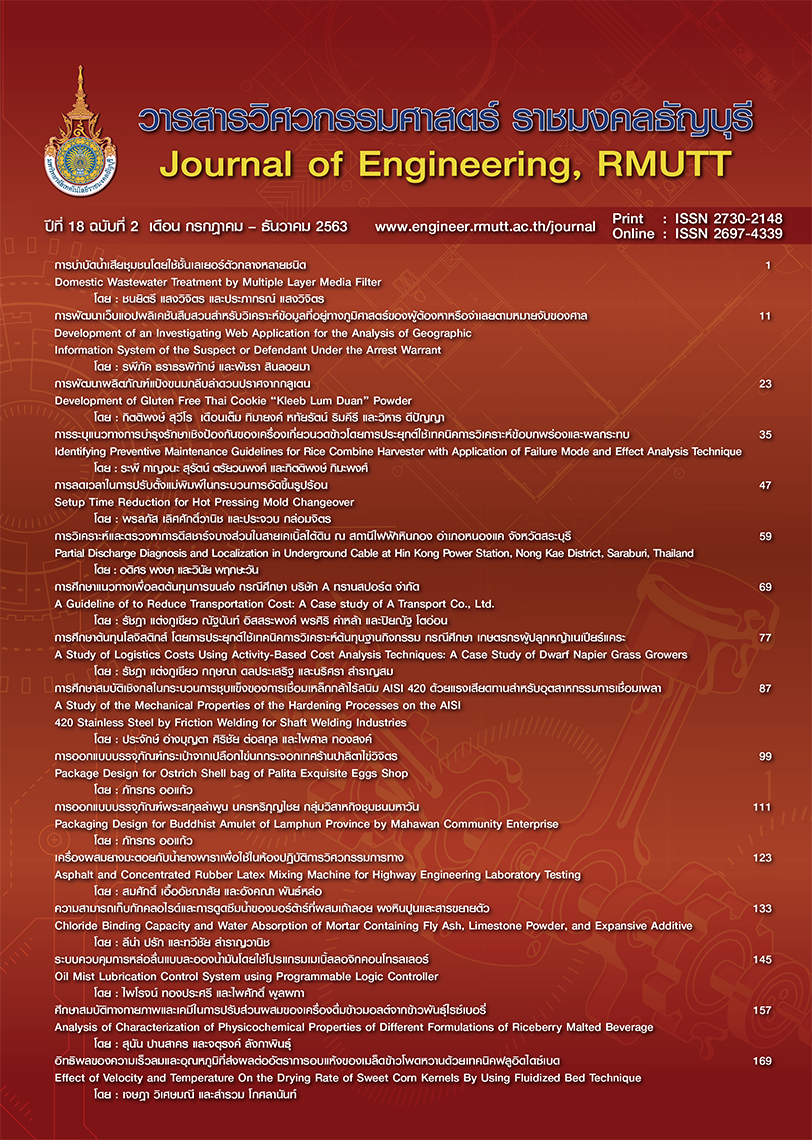Identifying Preventive Maintenance Guidelines for Rice Combine Harvester with Application of Failure Mode and Effect Analysis Technique
Main Article Content
Abstract
This research aims to study the risk factors of the rice combine harvester by using failure mode and effect analysis (FMEA) technique. The research methodology began with classifying failure modes and causes during harvesting rice. After that, each type of failure mode was evaluated and calculated a risk priority number (RPN), then, RPN is sorted in descending order. Machine parts belonging to a high risk group were investigated a root cause of failure occurrence and then determined preventive maintenance guidelines. From data analysis, it illustrated that there were five types of risk classified as a high risk group; F21 wear of chain surface, F19 wear of rubber O-ring, F14 wear of ball roller surface, F10 sprocket gear broken and
F12 lead wheel broken. This high risk group implied that if some failures occur, the combine harvester can be stopped which caused harvesting operation interruption. As a result, a development of preventive maintenance guidelines was needed. This research provides the self-preventive maintenance guidelines for farmer who used the rice combine harvester which the results of self-preventive maintenance help extending the useful life of each parts and enhancing work efficiency of the rice combine harvester.
Article Details
The manuscript, information, content, picture and so forth which were published on Frontiers in engineering innovation research has been a copyright of this journal only. There is not allow anyone or any organize to duplicate all content or some document for unethical publication.
References
Selling a Rice Conbinr Harveter [Internet].Bangkok: Denchai Karnchang 2018 August- [cited 2018 August 14] Available from: http://densakchai.blogspot.com/2013/02/blog-post_2.html
Thai Rice [Internet]. Bankok: Department of Trade Negotiations 2018 August-[cited 2018 August 14] Available from:http://www.thaifta.com
Kaeowongsa S, Phanritdum. The application of FEMA to reduce errors in engineering design of project management.Proceeding of Industrial Engineering Network 2555; 2012 October 17-19;Petchburi, Thailand: 879-85 (In Thai).
Samrit S, Kengpol A, Talabgaew S. Reduction of downtime loss by using reliability theory based preventive maintenance:a case study of the concrete industry.KKU Research Journal.2011;16(2):145-
(In Thai).
Wongjirattikarn S, Ratanakuakangwan S.Improvement of preventive maintenance planning of an automobile shaft manufacturer by FMEA technique. The Journal of KMUTTNB. 2013;23(3):643-53
(In Thai).
Jafari H, Saeidi N, Saffari R. Development of FMEA as effective tool for risks assessment in the iraqi container terminals.World of Sciences Journal. 2013;1: 26-32.
Rakesh R, Jos BC, Mathew G. FMEA analysis for reducing breakdowns of a sub system in the life care product manufacturing industry. Inter. J. of Engineering Science and Innovative Technology. 2013;2: 218-25.
Shafiee M, Dinmohammadi F. An FMEA based risk assessment approach for wind turbine systems: a comparative study of onshore and offshore. Energies. 2014;7:619-42.
Vinodh S, Aravindraj S, Ravi SN,Yogeshwaran N. Fuzzy assessment of FMEA for rotary switches: a case study.The TQM Journal.2012;24:461-75.
Thivel PX, Bultel Y, Delpech F. Risk analysis of a biomass combustion process using MOSAR and FMEA methods. Journal of Hazardous Materials. 2008;151: 221-31.
Huadong Y, Zhigang B. Risk evaluation of boiler tube using FMEA. Proceedings of the 6th International Conference on Fuzzy Systems and Knowledge Discovery; 2009 August 14-16; Tianjin,
China: 81-5.


